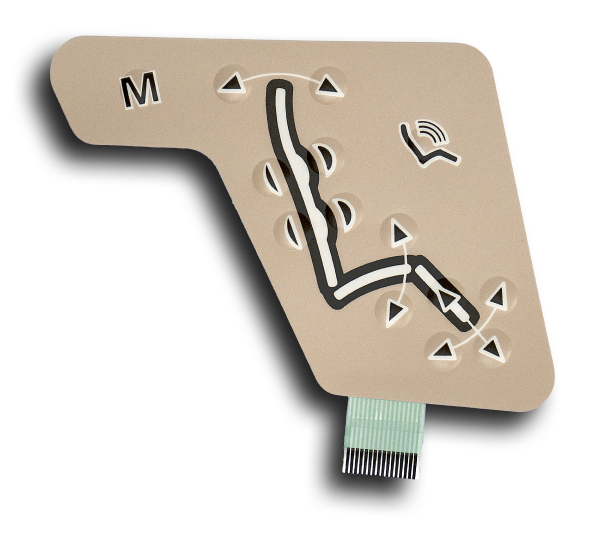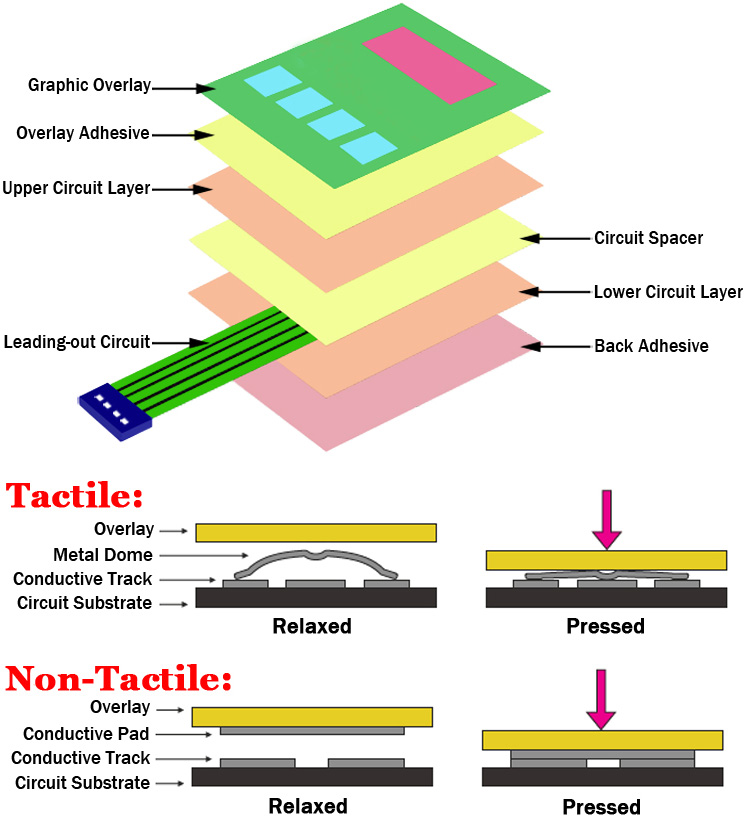The role of membrane switch in connected consumer appliances
The Manufacturing Refine Behind Membrane Change: What You Need to Know
The production process behind membrane switches over combines cautious layout, material choice, and quality assurance. It starts with understanding the ins and outs of membrane switch layout and progresses via numerous stages, consisting of product options and printing strategies. Each phase plays a crucial role in making certain capability and toughness. The complexities of layer building and construction and the strenuous testing requirements may disclose understandings that are not instantly evident. What exists past these foundational aspects?
Comprehending Membrane Layer Switch Design
Membrane layer buttons might appear easy at very first glimpse, their style includes detailed factors to consider that assure capability and toughness. The style procedure begins with a comprehensive understanding of customer demands, including the user interface's desired application and ecological elements. Functional designs is a crucial element, as the design should help with ease of usage while making certain that responsive comments satisfies user expectations.Moreover, the layering of components, such as visuals overlays, glue layers, and conductive traces, should be exactly engineered. membrane switch. This split arrangement not only influences the button's responsiveness yet likewise influences its long life. Interest is offered to the securing strategies utilized to protect versus wetness and dust, which can compromise performance. Furthermore, layout factors to consider encompass appearances, where color schemes and visual clearness enhance user experience. Ultimately, the design of membrane switches balances performance, user experience, and toughness, ensuring that they fulfill the needs of numerous applications effectively
Materials Used in Membrane Change Manufacturing
When selecting products for membrane button production, it is important to ponder both performance and longevity. The main products include polyester and polycarbonate movies, which provide adaptability and stamina. These movies are typically covered with adhesive to ensure proper bonding to substrates. Conductive inks, commonly composed of silver or carbon, are crucial for developing electrical connections within the button, enabling for reliable operation.Additionally, a protective layer, such as a difficult coat, is often related to enhance scratch resistance and durability. The selection of backing material, such as acrylic or foam, can significantly affect the button's responsive feel and overall customer experience. Different ecological factors, including temperature and humidity, should direct product selection to ensure peak performance in details applications. Inevitably, the right combination of materials adds to the membrane layer switch's performance and life expectancy, making educated selections essential for producers.
The Printing Process: Creating Graphics and Text
The printing process in membrane switch manufacturing plays a significant role in producing top quality graphics and text. Various visuals style methods are utilized to guarantee visual appeal and capability, while mindful ink option techniques are necessary for longevity and efficiency. Recognizing these aspects is essential for achieving best cause membrane layer button layout.
Graphic Design Techniques
Graphic layout methods play a vital role in the printing procedure of membrane buttons, as they define how graphics and message will eventually appear on the end product. Efficient graphic style involves the critical use fonts, shades, and layouts to boost readability and visual allure. Designers usually use vector graphics for scalability, ensuring that pictures continue to be sharp at different dimensions. Additionally, interest to comparison and alignment is crucial, as it influences individual interaction and aesthetic top quality. The consolidation of branding elements, such as logo designs, should be managed with like preserve brand stability. Overall, thoughtful graphic style techniques contribute considerably to the functionality and beauty of membrane layer buttons, impacting customer experience and item performance.
Ink Option Techniques
Choosing the ideal ink is crucial for attaining the wanted visual quality and longevity in membrane layer button manufacturing. Various ink kinds are made use of, including solvent-based, water-based, and UV-curable inks. Each type provides unique features, such as resistance, adhesion, and adaptability to ecological variables. Solvent-based inks are often favored for their resilience and dynamic colors, while water-based inks are much more eco-friendly however might have restrictions in bond. UV-curable inks offer rapid curing and durable efficiency. Furthermore, color matching techniques ensure that the chosen inks align with design specifications. Inevitably, the selection of ink need to think about variables such as application approach, substratum compatibility, and end-use demands to achieve superior lead to membrane layer switch graphics and message.
Layer Building And Construction and Assembly

Material Choice Refine
A mindful selection of materials is important in the manufacturing process of membrane switches, as it directly influences functionality and sturdiness. The main products utilized include polyester, polycarbonate, and different conductive inks. Polyester is typically preferred for its exceptional resistance to chemicals and abrasion, making it appropriate for severe atmospheres. Polycarbonate, on the various other hand, supplies remarkable clearness and effect resistance, which is useful for applications needing visibility and robustness. Conductive inks, typically composed of silver or carbon, are essential for developing reliable electric paths. Furthermore, the choice of glue products affects the overall integrity of the button - membrane switch. Reviewing variables such as environmental exposure, tactile responses, and visual demands guides suppliers in selecting the ideal materials for their particular applications
Layer Adhesion Strategies
Sticking layers in membrane button building and construction is a crucial procedure that ensures functionality and longevity. Numerous adhesion strategies are utilized to secure excellent bonding between layers, which typically consist of making use of adhesives, warmth, and pressure. Pressure-sensitive adhesives (PSAs) are commonly used for their ease of application and instant bonding capabilities. In addition, thermal bonding strategies can be applied, where warmth is used to turn on adhesive properties, safeguarding a strong bond. The option of attachment method largely relies on the materials included and the details application requirements of the membrane layer button. Proper placement and consistent application of adhesives are important to avoid issues, securing the switch runs effectively throughout its intended life expectancy.
Quality Control Measures
Ensuring top quality control throughout the layer building and construction and setting up of membrane layer switches is vital for keeping efficiency and reliability. This process usually entails a number of essential measures, including complete inspections at each stage of production. Producers use sophisticated screening approaches, such as peel tests and bond evaluations, to confirm the stability of layer bonds. In addition, aesthetic examinations are performed to recognize any kind of issues in printing or material disparities. Environmental conditions, such as temperature and humidity, are carefully kept track of to guarantee perfect curing and adhesion. Normal calibration of devices assists maintain precise manufacturing standards. By applying these top quality control actions, makers can significantly decrease the risk of item failing, guaranteeing that the last membrane layer switches satisfy the required requirements and client expectations.
Testing and Top Quality Control Procedures

Advancements in Membrane Change Modern Technology
As innovations in technology remain to advance, membrane layer switches are taking advantage of innovative developments that enhance their capability and individual experience. One notable innovation is the integration of capacitive touch modern technology, which permits even more intuitive and receptive individual interfaces. This change not only enhances aesthetic appeals however also decreases mechanical wear and tear, extending the life-span of the switches.Additionally, improvements in visuals overlay materials have actually led to enhanced resilience and resistance to environmental factors such as moisture and UV light. These materials now supply boosted quality and brightness, further raising the visual appeal.Furthermore, the unification of smart modern technology is changing membrane layer changes right into interactive control board, enabling connection with IoT tools. This connection fosters a seamless individual experience, leading the way for applications in various markets, from healthcare to consumer electronic devices. Jointly, these advancements placement membrane layer changes as crucial parts in modern device style.
Frequently Asked Questions
For how long Does the Membrane Layer Switch Over Manufacturing Process Take?
The period of the membrane switch production process can differ significantly. Factors such as intricacy, products used, and manufacturing quantity impact timelines, with common manufacturing ranging from a few days to several weeks for completion.
What Are the Usual Applications for Membrane Layer Switches?
Membrane layer buttons are generally used in numerous markets, consisting of vehicle controls, home devices, medical devices, and customer electronics (membrane switch). Their adaptability and resilience make them excellent for applications needing user-friendly interfaces and reliable performance in varied environments
Can Membrane Switches Over Be Custom-made for Details Needs?

What Is the Life expectancy of a Normal Membrane Switch?
The lifespan of a regular membrane button varies, but generally, it varies from 1 to 5 million cycles. Variables such as use, environment, and material high quality significantly influence sturdiness and overall performance with time.

Are Membrane Layer Switches Over Eco-friendly?
The environmental kindness of membrane layer switches differs. Some products used might not be recyclable, while others can be environmentally friendly. The general effect depends browse around these guys on producing practices and materials, demanding cautious factor to consider throughout choice and disposal. The manufacturing procedure behind membrane layer switches combines careful design, material option, and high quality control. It begins with recognizing the complexities of membrane layer button layout and advances via various stages, including material options and printing techniques. When choosing products for membrane switch manufacturing, it is necessary to ponder both performance and sites durability. A mindful selection of materials is essential in the manufacturing process of membrane layer buttons, as it straight influences functionality and resilience. The option of bond method mainly depends on the materials involved and the certain application requirements of the membrane layer button.